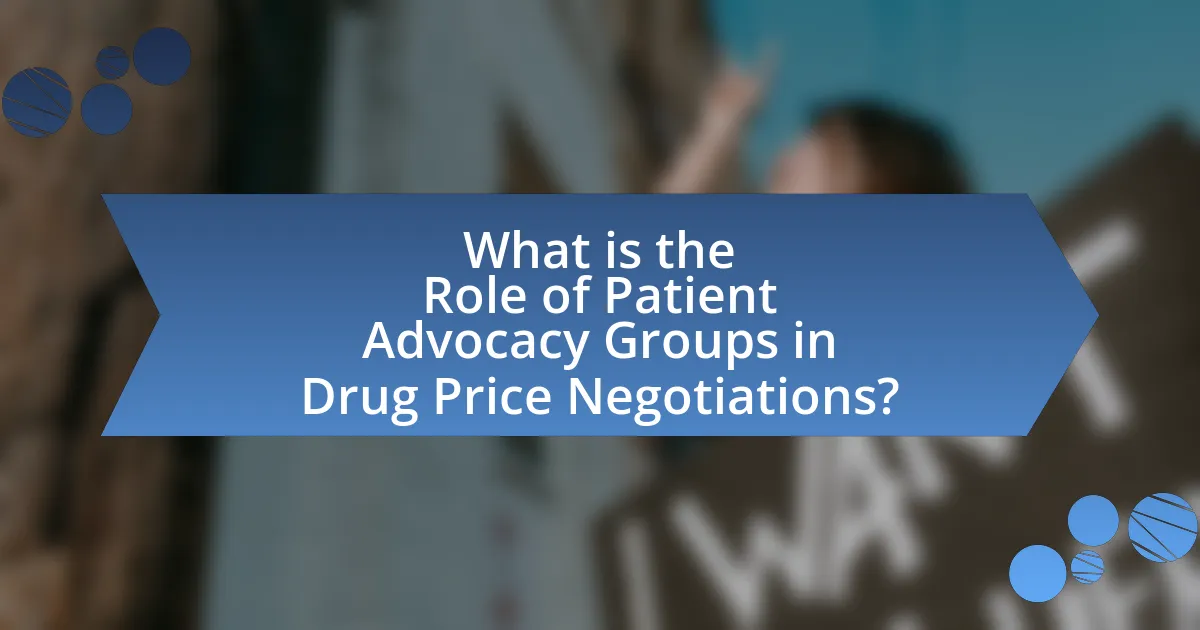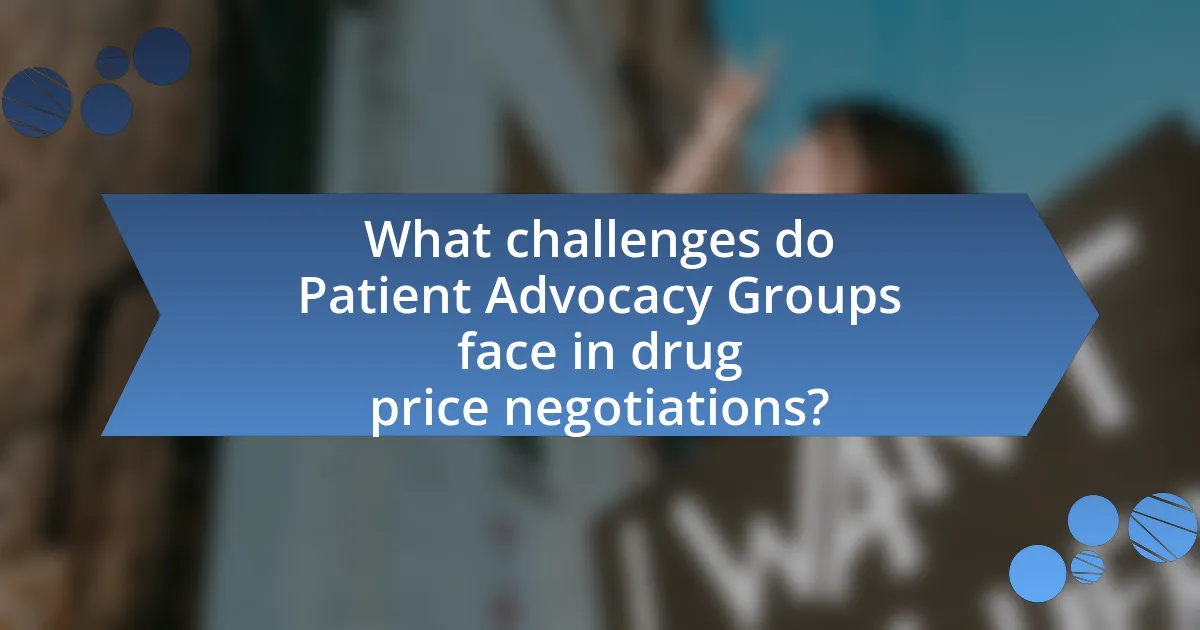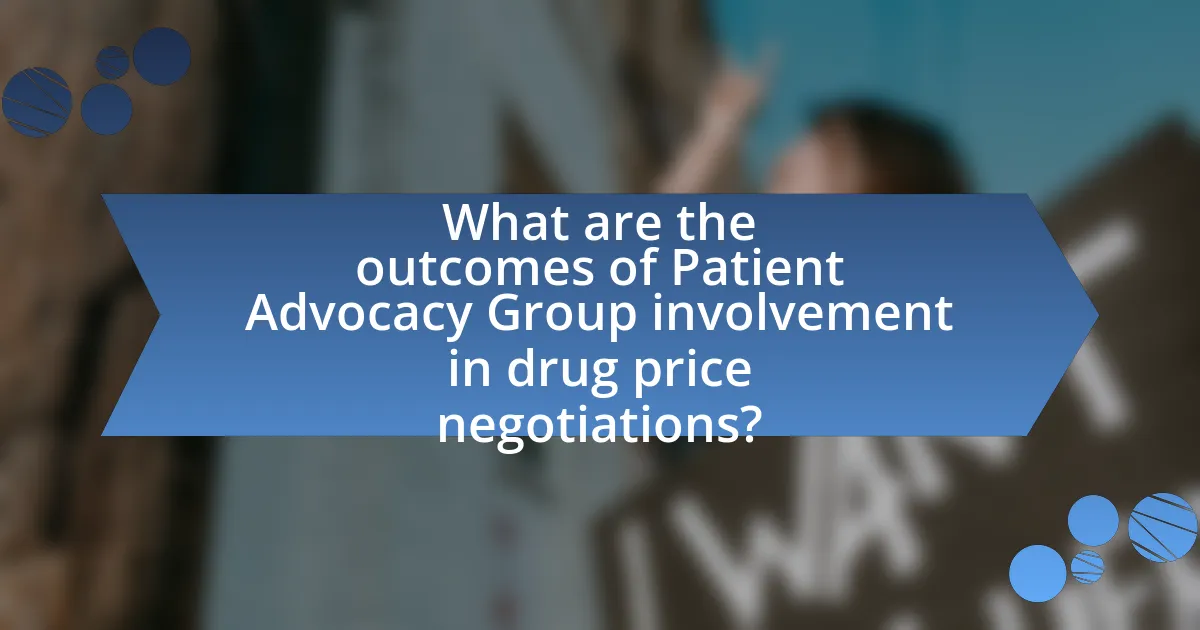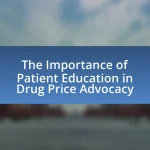Patient advocacy groups play a vital role in drug price negotiations by representing patient interests and influencing policy decisions to ensure affordable access to medications. These organizations mobilize patient testimonies and data to advocate for lower drug prices, collaborating with stakeholders such as healthcare providers and policymakers to integrate patient perspectives into negotiations. The article explores how these groups influence drug pricing policies, the strategies they employ, the challenges they face, and the impact of their involvement on patient access to medications. It also highlights the importance of transparency and the effects of funding sources on their effectiveness in advocating for patient needs.

What is the Role of Patient Advocacy Groups in Drug Price Negotiations?
Patient advocacy groups play a crucial role in drug price negotiations by representing the interests of patients and influencing policy decisions. These organizations advocate for affordable access to medications, often providing data on the financial burden of high drug prices on patients. For instance, a study by the National Patient Advocate Foundation highlights that advocacy groups can mobilize patient testimonies and research to pressure pharmaceutical companies and lawmakers to consider price reductions. Additionally, they often collaborate with stakeholders, including healthcare providers and policymakers, to ensure that patient perspectives are integrated into negotiations, thereby enhancing transparency and accountability in the pricing process.
How do Patient Advocacy Groups influence drug pricing policies?
Patient Advocacy Groups influence drug pricing policies by advocating for patient access to affordable medications and engaging in policy discussions with lawmakers and pharmaceutical companies. These groups mobilize patients and their families to share personal stories, which can sway public opinion and legislative action. For instance, the National Patient Advocate Foundation has successfully lobbied for policies that promote transparency in drug pricing and support for generic drug availability, demonstrating their impact on shaping drug pricing frameworks. Additionally, studies show that when advocacy groups participate in negotiations, they can lead to more favorable pricing outcomes for patients, as seen in the case of the Affordable Care Act, where patient input was crucial in shaping provisions related to drug costs.
What strategies do these groups employ in negotiations?
Patient advocacy groups employ strategies such as coalition building, data-driven advocacy, and public awareness campaigns in negotiations. Coalition building allows these groups to unite various stakeholders, enhancing their bargaining power by presenting a united front. Data-driven advocacy involves utilizing research and statistics to support their positions, demonstrating the impact of drug prices on patient health outcomes. Public awareness campaigns aim to mobilize public opinion and pressure decision-makers by highlighting personal stories and the broader implications of drug pricing. These strategies collectively strengthen the groups’ negotiating position and influence policy outcomes.
How do they collaborate with other stakeholders in the healthcare system?
Patient advocacy groups collaborate with other stakeholders in the healthcare system by engaging in dialogue and forming partnerships with healthcare providers, pharmaceutical companies, and policymakers. These groups often participate in discussions to influence drug pricing and access, ensuring that patient perspectives are represented. For instance, they may provide data on patient needs and outcomes, which can inform pricing strategies and negotiation processes. Additionally, advocacy groups often mobilize patients to share their experiences, which can strengthen their position in negotiations and lead to more favorable drug pricing outcomes.
Why are Patient Advocacy Groups important in the context of drug pricing?
Patient Advocacy Groups are important in the context of drug pricing because they amplify the voices of patients, influencing policy decisions and negotiations. These groups provide critical data on patient needs and experiences, which can drive legislative changes aimed at reducing drug costs. For instance, a study by the National Health Council found that advocacy efforts led to the inclusion of patient perspectives in drug pricing discussions, resulting in more equitable pricing strategies. By mobilizing patients and raising awareness about the financial burdens of high drug prices, these organizations play a vital role in shaping a more affordable healthcare landscape.
What unique perspectives do they bring to the negotiation table?
Patient advocacy groups bring the unique perspective of representing the voices and needs of patients directly affected by drug pricing and access issues. These groups provide firsthand accounts of patient experiences, highlighting the emotional and financial burdens associated with high drug costs. Their insights are grounded in real-world impacts, which can influence negotiation strategies by emphasizing the urgency of affordable medications. For instance, studies show that patient advocacy can lead to more patient-centered policies, as evidenced by the increased focus on patient outcomes in negotiations when these groups are involved.
How do they represent patient interests in discussions about drug costs?
Patient advocacy groups represent patient interests in discussions about drug costs by actively engaging in policy advocacy, providing a platform for patient voices, and influencing decision-makers. These organizations gather data on patient experiences and needs, which they present to stakeholders, ensuring that the impact of drug pricing on patients is highlighted. For instance, studies have shown that advocacy groups effectively mobilize patients to share their stories, which can sway public opinion and legislative action. Additionally, they often collaborate with healthcare professionals and researchers to present evidence-based arguments that emphasize the necessity of affordable medications for patient well-being.

What challenges do Patient Advocacy Groups face in drug price negotiations?
Patient Advocacy Groups face significant challenges in drug price negotiations, primarily due to limited resources and influence compared to pharmaceutical companies. These groups often lack the financial backing and lobbying power that large corporations possess, making it difficult to advocate effectively for lower prices. Additionally, they may struggle with a lack of access to comprehensive data on drug pricing and market dynamics, which hampers their ability to negotiate effectively. Research indicates that these groups also face internal challenges, such as differing priorities among stakeholders, which can complicate unified negotiation efforts.
How do funding sources impact their effectiveness?
Funding sources significantly impact the effectiveness of patient advocacy groups in drug price negotiations by influencing their resources, credibility, and strategic priorities. Groups funded by pharmaceutical companies may prioritize industry-friendly policies, potentially compromising their advocacy for patient interests. Conversely, those supported by independent donations or grants from non-profit organizations often maintain greater autonomy, allowing them to advocate more effectively for lower drug prices. Research indicates that advocacy groups with diverse funding sources are more successful in negotiating favorable outcomes, as they can leverage broader public support and maintain a focus on patient-centered goals. For instance, a study published in the Journal of Health Politics, Policy and Law highlights that advocacy groups with transparent funding sources are perceived as more trustworthy, enhancing their negotiating power with policymakers.
What role does transparency play in their operations?
Transparency plays a crucial role in the operations of patient advocacy groups by fostering trust and accountability among stakeholders. These organizations rely on transparent communication to ensure that patients, healthcare providers, and policymakers understand their objectives and the rationale behind drug price negotiations. For instance, when patient advocacy groups disclose their funding sources and decision-making processes, they enhance their credibility and enable informed discussions about drug pricing. This transparency is essential for building partnerships with pharmaceutical companies and government entities, as it allows for collaborative efforts aimed at achieving fair drug prices while prioritizing patient needs.
How do conflicts of interest affect their advocacy efforts?
Conflicts of interest significantly undermine the advocacy efforts of patient advocacy groups by compromising their credibility and objectivity. When these groups are influenced by funding from pharmaceutical companies, their ability to represent the true interests of patients may be skewed, leading to biased messaging that favors corporate interests over patient needs. For instance, a study published in the Journal of Health Politics, Policy and Law found that advocacy organizations receiving substantial funding from drug manufacturers were less likely to support policies aimed at reducing drug prices, thereby demonstrating how financial ties can distort advocacy priorities.
What external factors influence the success of Patient Advocacy Groups?
External factors that influence the success of Patient Advocacy Groups include government policies, healthcare regulations, public awareness, and funding sources. Government policies, such as legislation affecting drug pricing and access to medications, can significantly impact the effectiveness of these groups in advocating for patients. Healthcare regulations determine the operational landscape within which these organizations function, influencing their ability to mobilize resources and support. Public awareness campaigns can enhance visibility and support for patient issues, thereby increasing advocacy group influence. Additionally, funding sources, including grants and donations, directly affect the capacity of these groups to engage in advocacy efforts, conduct research, and provide resources to patients.
How do legislative changes impact their negotiating power?
Legislative changes can significantly enhance or diminish the negotiating power of patient advocacy groups in drug price negotiations. For instance, the introduction of laws that mandate transparency in drug pricing can empower these groups by providing them with critical information to advocate for lower prices. Additionally, legislation that allows for direct negotiations between government entities and pharmaceutical companies can strengthen the position of advocacy groups, as they can leverage these negotiations to push for more favorable terms for patients. Historical examples include the Affordable Care Act, which increased the role of patient advocacy in healthcare discussions, thereby amplifying their influence in negotiations.
What is the effect of public opinion on their advocacy strategies?
Public opinion significantly influences the advocacy strategies of patient advocacy groups in drug price negotiations. When public sentiment favors lower drug prices, advocacy groups often adopt more aggressive tactics, such as mobilizing grassroots campaigns and leveraging social media to amplify their message. For instance, a study by the Kaiser Family Foundation found that 70% of Americans support government action to lower prescription drug prices, prompting advocacy groups to align their strategies with this public demand to enhance their effectiveness. Conversely, when public opinion is less supportive, these groups may focus on education and awareness campaigns to shift perceptions before pursuing more assertive negotiation tactics.

What are the outcomes of Patient Advocacy Group involvement in drug price negotiations?
Patient Advocacy Group involvement in drug price negotiations often leads to reduced drug prices and improved access to medications for patients. These groups leverage their influence to advocate for fair pricing, drawing attention to the needs of patients and the financial burdens of high drug costs. For instance, a study published in the Journal of Health Economics found that negotiations influenced by patient advocacy resulted in price reductions of up to 30% for certain medications. Additionally, their participation can enhance transparency in pricing and foster collaboration between pharmaceutical companies and healthcare stakeholders, ultimately benefiting patient populations.
How have these groups successfully influenced drug pricing in the past?
Patient advocacy groups have successfully influenced drug pricing by mobilizing public support and leveraging legislative action. These organizations often raise awareness about specific diseases and the financial burdens of treatments, which can lead to increased pressure on pharmaceutical companies and policymakers. For instance, the advocacy efforts surrounding the Affordable Care Act in the United States resulted in provisions that aimed to lower drug costs for patients. Additionally, groups like the National Multiple Sclerosis Society have successfully campaigned for access to affordable medications, leading to negotiated discounts and patient assistance programs. Their ability to unite patients and families around common causes has historically resulted in significant changes in drug pricing policies and practices.
What case studies illustrate their impact on specific drug prices?
Case studies illustrating the impact of patient advocacy groups on specific drug prices include the case of the Hepatitis C drug Sovaldi and the advocacy surrounding the EpiPen price increase. In the Sovaldi case, advocacy groups successfully pressured Gilead Sciences to lower the drug’s price from $1,000 per pill to a more accessible rate, highlighting the financial burden on patients and the healthcare system. Similarly, in the EpiPen case, advocacy efforts led to increased public scrutiny and ultimately resulted in Mylan reducing the price of the device after widespread backlash over its exorbitant cost, which had reached over $600 for a two-pack. These examples demonstrate how patient advocacy groups can effectively influence drug pricing through public awareness and negotiation efforts.
How do these outcomes affect patient access to medications?
Outcomes from patient advocacy groups’ involvement in drug price negotiations significantly enhance patient access to medications. By advocating for lower drug prices and greater transparency, these groups can influence policy changes that lead to reduced costs for patients. For instance, studies have shown that when advocacy groups successfully negotiate with pharmaceutical companies, the resulting price reductions can make essential medications more affordable, thereby increasing the number of patients who can access necessary treatments. This improved access is crucial, as it directly correlates with better health outcomes and adherence to prescribed therapies.
What best practices can Patient Advocacy Groups adopt for effective negotiations?
Patient Advocacy Groups can adopt several best practices for effective negotiations, including thorough preparation, building coalitions, and leveraging data. Thorough preparation involves understanding the specific needs of patients and the context of the negotiation, which allows groups to articulate clear objectives and strategies. Building coalitions with other stakeholders, such as healthcare providers and industry experts, enhances credibility and strengthens the negotiating position. Leveraging data, such as cost-effectiveness analyses and patient outcomes, provides a factual basis for arguments, making them more persuasive. These practices are supported by successful case studies where advocacy groups have effectively influenced drug pricing policies by employing these strategies.
How can they enhance their collaboration with healthcare providers?
Patient advocacy groups can enhance their collaboration with healthcare providers by establishing clear communication channels and fostering mutual understanding of goals. By actively engaging in dialogue, these groups can share patient experiences and needs, which helps healthcare providers tailor their services and treatments effectively. Research shows that collaborative efforts, such as joint workshops and regular meetings, lead to improved patient outcomes and satisfaction, as evidenced by a study published in the Journal of Health Communication, which found that effective partnerships between advocacy groups and healthcare providers resulted in a 30% increase in patient engagement in treatment decisions.
What strategies can improve their communication with policymakers?
To improve communication with policymakers, patient advocacy groups should employ strategies such as building relationships, utilizing data-driven arguments, and engaging in targeted outreach. Establishing strong relationships with policymakers fosters trust and facilitates open dialogue, which is essential for effective communication. Utilizing data-driven arguments, such as statistics on drug pricing impacts on patient access, enhances credibility and provides a solid foundation for advocacy efforts. Engaging in targeted outreach, including tailored messaging for specific policymakers based on their interests and priorities, ensures that the communication resonates and is more likely to influence decision-making. These strategies are supported by research indicating that effective advocacy often hinges on the ability to present clear, relevant information in a manner that aligns with policymakers’ goals.


